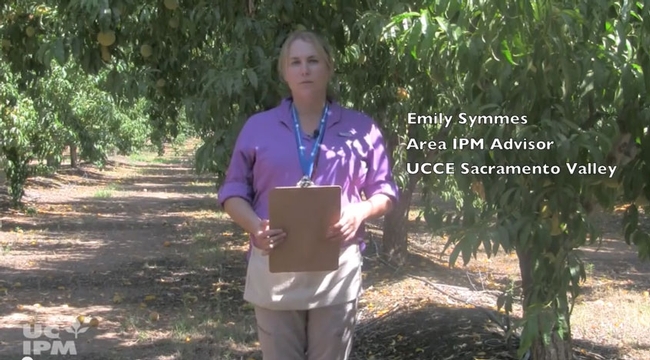
The UC Agriculture and Natural Resources Statewide Integrated Pest Management (IPM) program teamed up with UC ANR farm advisors to develop a series of how-to videos that can help growers and pest control advisers monitor for pests and damage and determine if and when treatment is needed.
In one video, Sacramento Area IPM advisor Emily Symmes gives a brief overview of how to monitor for webspinning spider mites. Spider mites build up in stone fruit trees as the weather warms up. Late spring through summer is the ideal time to monitor for mites and their damage, which includes leaf stippling and webbing. If mites build up too much, leaves can drop, fruit may not fully develop, and branches and fruit can be exposed to sunburn.
Shoot strikes, or dead drooping leaf tips, are often seen on young peach and nectarine trees. In a second video, UC ANR farm advisor Janine Hasey explains how to monitor for shoot strikes and how to distinguish the culprits, Oriental fruit moth and peach twig borer. Although Oriental fruit moth and peach twig borer can bore into both foliage and fruit, they cause the most devastating damage by feeding on fruit. Early season monitoring and treatment can prevent future fruit loss.
In plum and prune orchards, leaf curl aphids and mealy plum aphids cause leaves to curl and become distorted. Aphids produce honeydew, which can lead to the development of sooty mold, causing fruit to crack and blacken. Aphids are often present when leaves start to grow. In his video, Rick Buchner, UC ANR farm advisor for Tehama County, discusses how to monitor for aphids and explains how to decide when treatment is warranted.
In a final video, UC ANR farm advisor Chuck Ingels teaches how to distinguish Phytophthora root and crown rot from bacterial canker. The two diseases are often confused because they both cause bark cankers. Phytophthora root and crown rot is confined to the lower trunk, but when a bacterial canker infection occurs in the tree trunk, the diseases can often be confused. Bacterial canker can be confirmed by cutting away the outer bark and looking for characteristic red flecks on the inner bark. Correct identification of these diseases will help in choosing a management strategy.
You can find all of these how-to videos on the UC IPM video library page. For specific information about managing pests in stone fruits or other crops, see the Pest Management Guidelines.